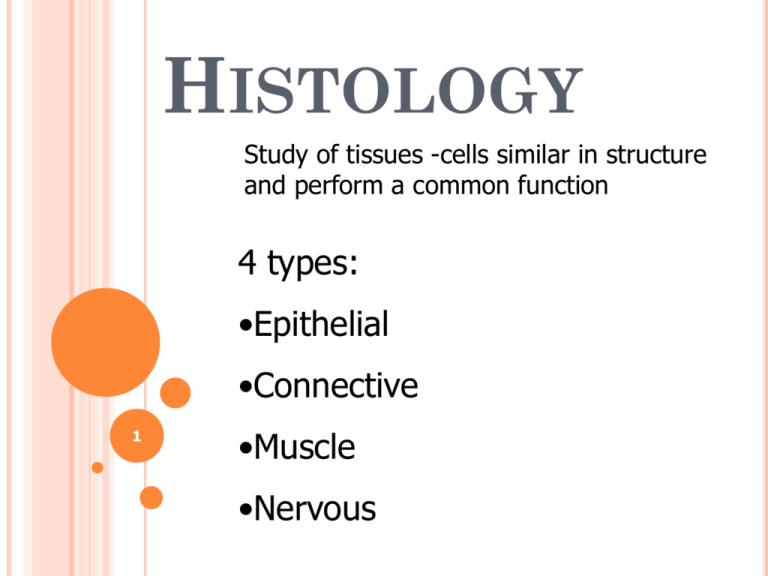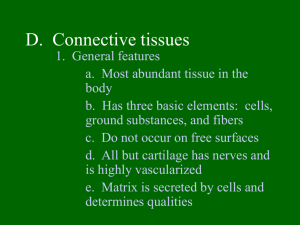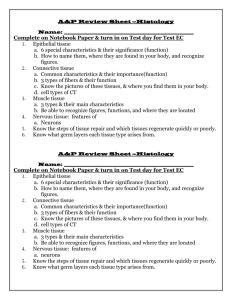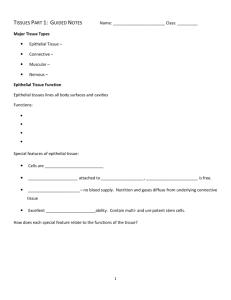Histology
advertisement

HISTOLOGY Study of tissues -cells similar in structure and perform a common function 4 types: •Epithelial •Connective 1 •Muscle •Nervous WHAT IS NECROSIS? Necrosis is tissue death. It occurs if the blood supply to an area is stopped for too long. When this happens the tissues die due to a lack of oxygen to the cells. 2 PREPARING TISSUES FOR MICROSCOPY Fixed – preserved Artifacts – distortions not seen in living tissue Sectioned – cut into slices thin enough light can pass through Stained – organic dyes used to enhance contrast Transmission electron microscopy (TEM) – uses electrons for detailed contrast Scanning electron microscopy (SEM) – 3D pictures of tissue surface 3 EPITHELIAL TISSUE Covers a surface or lines a cavity Glandular epithelium – exocrine glands Forms boundaries Basement Membrane: Network of protein fibers that forms barrier between epithelium and connective tissue Protection Absorption – molecules pass into blood or lymph Filtration – passage of solvent thru a membrane Excretion – eliminate waste Secretion – release aqueous solution Sensory reception 4 CHARACTERISTICS OF EPITHELIUM Polarity Apical surface – exposed Basal Surface – attached Microvilli Increase surface area Allow absorption and secretion Cilia Beat to move materials across surface Basal lamina – adhesive glycoproteins Specialized Contacts Tight Junctions Prevents passage of water and solutes Interlocking membrane proteins Basal adhesion belt binds cells together Desmosomes Durable interconnections 2 types: Button desmosomes- small disk Hemidesmosomes – half button shape 5 MORE CHARACTERISTICS Reticular lamina – Extracellular collagen network Avascular but innervated EPITHELIUM Supported by connective tissue OF No blood vessels, nutrients obtained from diffusion Nerve supply Regeneration Cells are continually replaced Epithelial cells only survive 1-2 days 7 SQUAMOUS EPITHELIUM Simple Squamous Thin and flat cells, 1 Layer Function: diffusion & filtration Found: forms capillary walls (endothelium), lining air sacs of lungs, kidneys, lining body cavities (mesothelium) Stratified Squamous Thin and flat cells, More than 1 layer, most common epithelia Function: protection Found: in places of mechanical stress, skin surface, lining tongue, mouth, esophagus, and anus 8 CUBOIDAL EPITHELIUM Simple Cuboidal Box shaped cells, 1 layer Function: Secretion or absorption Found: covering surface of ovaries, lining kidney tubules, salivary ducts, and pancreatic ducts Stratified Cuboidal Box shaped cells, 2 layers, rare Function: strengthen lumen walls Found: ducts of large sweat glands, salivary glands, mammary glands, and pancreas 9 COLUMNAR EPITHELIAL Simple Columnar Tall, rectangular cells, 1 layer Function: absorption (microvilli) & secretion Found: Lines stomach, intestinal tract, excretion ducts, gall bladder Pseudostratified Columnar Single layer irregularly shaped cells (looks like multiple layers) Function: protection, secretion Found: Lining respiratory passageways (ciliated), and auditory tubes 10 TRANSITIONAL EPITHELIAL TISSUE Transitional 3-6 layers of rounded cells Function: Withstands stretching Found: Lines urinary bladder and portions of ureters and urethra 11 EXOCRINE GLANDULAR EPITHELIA Exocrine glands: excrete secretions usually thru ducts onto surface Unicellular Goblet & mucous cells scattered among epithelial cells Secrete mucin (glycoproteins & water) via exocytosis Multicellular – Secretory sheet, classified by pattern of ducts ex – mucin lining stomach Mode of Secretion: Merocrine: via exocytosis Ex. Skin Perspiration, Mucus Glands, Saliva, mammary glands (milk) Apocrine: lose cytoplasm and secretory product Ex. Mammary glands (lipids) Holocrine – cell fills with secretion then bursts and dies Ex. Sebaceous glands – oils from base of hair 12 13 CLASSIFICATION OF CONNECTIVE TISSUES: 3 TYPES Connective Syrupy ground matrix Ex. Loose (areolar, adipose) & Dense (tendons & ligaments) Blood - Fluid Connective tissue Cells suspended in watery ground substance w/dissolved proteins Cartilage Tissue Proper Supporting Connective Tissue Dense ground substance (Hyaline, Elastic, Fibrocartilage) Bone Supporting Connective Tissue 14 CONNECTIVE TISSUES 3 Main Components Specialized cells Mostly nonliving extracellular matrix that surrounds cells Protein Fibers – collagen, elastic, reticular Ground Substance (fluid) – fills space between cells Interstitial fluid, Cell Adhesion Proteins, Proteoglycans Functions (vary widely) Binding & Supporting - framework Transport materials – fluid with dissolved material Storing Energy– fat in adipose tissue Insulating Protect Organs 15 CONNECTIVE TISSUE PROPER: CELL TYPES Fibroblasts Produce and maintain connective tissue fibers and ground substance Local maintenance & repair permanent Macrophages Adipocytes Defense: Engulf damaged cells and pathogens Release chemicals to stimulate immune response Fixed or migrating (reinforcement) Permanent fat cells store nutrients Droplet of lipid pushes nucleus to side Mast Cells Mobile, found near blood vessels Have vesicles filled with chemicals to be released after an injury or infection Heparin -anticoagulant Histamine – leaky capillaries Proteases & other enzymes 16 CONNECTIVE TISSUE FIBERS Collagen Long, straight, unbranched, flexible Elastic Protein – elastin Wavy, branched, stretchy Reticular Fibers Thin, branching interwoven network 17 18 GROUND SUBSTANCE Fills spaces between cells, surrounds fibers Connective tissue proper – clear, colorless, syrupy to slow movement of pathogens 19 LOOSE CONNECTIVE TISSUE Areolar Tissue Adipose tissue- 90% adipose cells Contains all cells and fibers of connective tissue proper Separates skin from muscles Provides padding Allows movement Extensive blood supply Behind eyes, kidneys, heart, abdomen, buttocks, and breasts Reticular Tissue- dominated by reticular fibers Lymph nodes, bone marrow, and spleen 20 WHAT IS THE DIFFERENCE BETWEEN WHITE FAT AND BROWN FAT? White fat Pale yellow in color Found in adults Used for insulation, long term energy storage, & cushion Brown fat Highly vascular, contains lots of mitochondria Found in infants and young kids Metabolically very active, breaks down lipids fast Instead of absorbing energy, it releases heat to warm circulating blood to increase body temperature 21 DENSE (FIBROUS) CONNECTIVE TISSUE Consists of mostly collagen fibers Dense Regular – collagen fibers are parallel to resist tension Poorly vascularized Tendons – connect skeletal muscle to bone Aponeuroses – flat tendons (muscle to muscle or bone) Ligaments – contain elastic fibers, connect bone to bone Fascia – binds together muscles, bv, and nerves Dense Irregular – meshwork of thick collagen fibers Provides support in many directions (i.e. skin dermis) Joint and organ capsules 22 FLUID CONNECTIVE TISSUES Blood Plasma- watery matrix w/dissolved proteins Red blood cell (rbc) White blood cells (wbc) Platelets 23 CARTILAGE SUPPORTING CONNECTIVE TISSUE: Cartilage – gel w/embedded fibers Chondrocytes – cells found in lacunae derived from chondroblasts Avascular, therefore difficult to repair Lacks nerves Types: Hyaline – tightly packed collagen fibers, tough but flexible Elastic – elastic fibers, resilient and flexible Connects ribs to sternum, supports passageways of respiratory tract, covers bone surfaces in joints, tip nose, embryonic skeleton Flap of outer ear (pinna), epiglottis, auditory tube Fibrocartilage – mostly collagen fibers, durable and tough Between vertebrae, between pubic bones, around or within joints 24 Hyaline Cartilage Elastic Cartilage Fibrocartilage 25 BONE SUPPORTING CONNECTIVE TISSUE: Osseous tissue: Bone Matrix – hard calcium and flexible collagen, very little ground substance Osteocytes found w/in lacunae Lacunae surround blood vessels Canaliculi extend from central (Haversian) canal 26 Osseous Tissue 27 MUSCLE TISSUE Muscle tissue – interaction between the myofilaments myosin and actin create a contraction, highly vascular Skeletal – striated voluntary muscle Cardiac – striated involuntary muscle Large, multinucleated cells (long and slender) Incapable of dividing, but produced through stem cells Striations (series of bands) Only contract when stimulated by nerves Smaller striated cells, single nucleus Interconnected by intercalated discs Limited ability to repair Pacemaker cells establish a regular rate of contraction Smooth – nonstriated involuntary muscle Walls of blood vessels, hollow tube=like organs Small, slender cells w/ one nucleus Actin and myosin are scattered so no striations Can be repaired Can contract on own or by nervous system 28 NERVOUS TISSUE Specialized for conducting electrical impulses and responding to stimuli 2 Types Cells: Long cells w/ 3main parts: Neurons – communicate thru electrical events Neuralgia – physical support for neural tissue, supply nutrients to neurons Cell body w/ nucleus Dendrites – branching projections that receive info Axon – long projection (w/synaptic terminals) relays info to other cells Limited ability to repair 29 30 MEMBRANES Membranes - epithelia and connective tissues combine to form 4 types of membranes: Mucous Membranes Serous membranes Cutaneous membranes Synovial membranes 31 CUTANEOUS MEMBRANE Aka Skin – covers surface of body, thick, dry Stratified squamous epithelium and underlying dense connective tissue 32 MUCOUS MEMBRANES Mucosae – line cavities with exterior contact Digestive, respiratory, reproductive, and urogentital tracts Epithelial surfaces kept moist Ex. Simple columnar epithelia of dig. tract Stratified squamous epithelia of mouth Transitional epithelia of urinary tract 33 SEROUS MEMBRANES Minimizes friction when organ moves Line internal subdivisions of ventral body cavity Parietal – lines inner surface of cavity Visceral – lines outer surface or organs Simple epithelia supported by loose connective tissue Pleura – covers pleural cavity and lungs Peritoneum – lined abdominal cavity and associated organs Pericardium – lines pericardial cavity and heart 34 SYNOVIAL MEMBRANES Lines articulation (joint) capsule Loose connective tissue and incomplete layer of epithelial tissue Produce synovial fluid for smooth movements 35 Mucous Membrane Serous Membrane Cutaneous Membrane Synovial Membrane 36 TISSUE INJURY AND REPAIR Inflammation In response to pathogens, impact, abrasion, extreme temperatures, or chemical irritation Mast cells release histamine and heparin that dilate blood vessels to induce swelling, warmth, redness and pain Regeneration Fibroblasts produce dense collagen fibers called fibrous tissue (scar tissue) Fibrosis is the permanent replacement of normal tissues with fibrous tissue (i.e. heart and muscle tissues) 37 TISSUES AND AGING Speed and effectiveness of tissue repair decreases with age (change of hormones and lifestyle) Epithelia gets thinner, bones become brittle, cardiac muscle fibers and neurons cannot be replaced Osteoporosis – inactivity, low calcium, and decrease in estrogen result in poor bone strength 38







